Herbs annual, (7-)15-100(-150) cm tall. Trichomes primarily 3-or 4-fid, sometimes mixed with 5-fid ones, malpighiaceous trichomes primarily on stem and pedicels. Stems erect, often branched above, ribbed. Basal leaves rosulate, withered by fruiting. Middle and upper cauline leaves shortly petiolate or sessile; leaf blade lanceolate, linear, or elliptic-oblong, (1-)2-7(-11) cm × (2-)5-10(-20) mm, base cuneate, margin subentire or denticulate, rarely sinuate-dentate, apex acute or obtuse. Racemes corymbose, densely flowered, ebracteate, elongated considerably in fruit. Fruiting pedicels divaricate or ascending, 5-13(-16) mm, slender, much narrower than fruit. Sepals oblong, 1.8-3 × 0.5-1 mm, not saccate. Petals yellow, narrowly spatulate, 3-5 × 1.5-2 mm, apex rounded; claw distinct, subequaling sepals. Filaments yellow, 2-3.5 mm; anthers oblong, 0.5-0.7 mm. Ovules (20-)30-55 per ovary. Fruit linear, 4-angled, (1-)1.5-2.5(-4) cm × 1-1.3 mm, somewhat torulose, suberect or divaricate-ascending, straight; valves with a distinct midvein, outside with 3-5-forked trichomes, inside densely pubescent; style slender, 0.5-1.5 mm, cylindric; stigma slightly 2-lobed. Seeds oblong, 1-1.5 × 0.4-0.6 mm. Fl. May-Aug, fr. Jun-Sep. 2n = 16.
Annual, sometimes overwintering, herb. Hairs appressed, medifixed, sometimes stellate. Stems erect, up to 1 m tall. Rosette lvs simple, oblong-lanceolate, acute, shortly stalked, distantly toothed, hairy, 2-10 × 0.5-3 cm. Stem lvs narrower, smaller, becoming sessile. Racemes 10-30 cm long. Sepals hairy, 2-3 × c. 0.5 mm. Petals yellow, 4-6 × 2-3 mm. Silique 4-angled, slightly curved, 10-25 × c. 1.2 mm, erect on erecto-patent pedicel 5-10 mm long. Seeds brown, shortly winged at apex, 1-1.2 mm long.
Erect, often simple annual 2–10 dm; lvs linear to oblanceolate, entire or barely sinuate; sep 2–3.5 mm; pet bright yellow, 3.5–5.5 mm; mature racemes elongate, with straight rachis and slender, widely divergent pedicels (6–)8–12(–14) mm; frs ascending to erect, (1.2–)1.5–2.5(–3) cm; 2n=16. Usually in wet soil, but also a weed in fields and roadsides; originally European, but now circumboreal, s. in Amer. to N.C., Ark., Colo., and Oreg. June– Aug. (Cheirinia c.)
An annual herb. It has soft hairs. It grows 10-50 cm high. The leaves have short stalks. They are narrowly sword shaped and 2-5 cm long by 2-5 mm wide. They can be wavy and have teeth along the edge. The flowers are yellow and in groups at the top of the plant. The pods are narrow and 3-4 cm long. They are hairy.








